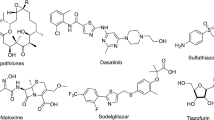Abstract
Conformational restriction constitutes a useful strategy of molecular modification for the design of new potential drug candidates. Herein we present the planning, antimicrobial evaluation, and establishment of structure–activity relationship (SAR) data for some isoxazole (3a–k, 8a–c, and 9a–c) and pyrazole (5a–h) derivatives. These derivatives were structurally designed by conformational restriction followed by bioisosteric exchange of previously described antimicrobial isoquinolines (1a–c). Some of these more conformationally restricted derivatives present improved properties as new antibacterial drug candidates.


Similar content being viewed by others
Abbreviations
- CLSI:
-
Clinical and Laboratory Standards Institute
- DMSO:
-
Dimethyl sulfoxide
- MIC:
-
Minimal inhibition concentration
- RPMI:
-
Roswell Park Memorial Institute
- SAR:
-
Structure–activity relation
- SI:
-
Selectivity index
- TLC:
-
Thin-layer chromatography
References
M. Yazaki, Y. Atsuta, K. Kato, S. Kato, S. Taniguchi, S. Takahashi, H. Ogawa, Y. Kouzai, T. Kobayashi, M. Inoue, R. Kobayashi, T. Nagamura-Inoue, H. Azuma, M. Takanashi, S. Kai, M. Nakabayashi, H. Saito, Biol. Blood Marrow Transplant. 15, 439–446 (2009)
J. Cadena, P. Sreeramoju, S. Nair, A. Henao-Martinez, J. Jorgensen, J.E. Patterson, Diagn. Microbiol. Infecti. Dis. 74, 16–21 (2012)
S.-Y. Lin, T.-C. Chen, F.-J. Chen, Y.-H. Chen, Y.-I. Lin, L.K. Siu, P.-L. Lu, J. Microbiol. Immunol. Infecti. (2012). doi:10.1016/j.jmii.2012.05.004
J. Vila, J. Sanchez-Cespedes, J.M. Sierra, M. Piqueras, E. Nicolas, J. Freixas, E. Giralt, Int. J. Antimicrob. Agents 28, 19–24 (2006)
E. Kamau, A. Grove, J. Mol. Biol. 342, 479–487 (2004)
B.J. Bradbury, M.J. Pucci, Curr. Opin. Pharmacol. 8, 574–581 (2008)
X. Ma, W. Zhou, R. Brun, Bioorg. Med. Chem. Lett. 19, 986–989 (2009)
L. Savini, L. Chiasserini, A. Gaeta, C. Pellerano, Bioorg. Med. Chem. 10, 2193–2198 (2002)
C.S. Cooper, M.D. Tufano, P.K. Donner, D.T.W. Chu, Bioorg. Med. Chem. 4(8), 1307–1315 (1996)
B. Bennani, A. Kerbal, M. Daoudi, B.F. Baba, G. Al Houari, A.F. Jalbout, M. Mimouni, M. Benazza, G. Demailly, M. Akkurt, S.Ö. Yýldýrým, T.B. Hadda, Arkivoc xvi, 19–40 (2007)
T.B. Hadda, B. Rahima, A. Kerbal, B.F. Baba, M. Akkurt, G. Demailly, M. Benazza, Arkivoc ii, 1–13 (2008)
B. Bennani, A. Jalbout, B.F. Baba, N.B. Larbi, A. Boukir, A. Kerbal, M. Mimouni, T.B. Hadda, B. Trzaskowski, Heterocycl. Chem. 44, 711–716 (2007)
T.B. Hadda, R. Badri, A. Kerbal, B.F. Baba, M. Akkurt, G. Demailly, M. Benazza, Arkivoc xiv, 276–288 (2007)
B. Bennani, A. Kerbal, N.B. Larbi and T.B. Hadda, OMPIC, Casablanca Moroccan Patent 2769 2004
B. Bennani, A. Kerbal, N.B. Larbi, T.B. Hadda, OMPIC, Casablanca Moroccan Patent 2771 2004
Clinical and Laboratory Standards Institute (CLSI; formerly NCCLS) National Committee for Clinical Laboratory Standarts, Approved standard. NCCLS document M100-S12, NCCLS, (Wayne, 2002)
B. Özçelik, M. Aslan, I. Orhan, T. Karaoglu, Microbiol. Res. 160, 159–164 (2005)
B. Özçelik, I. Orhan, G.Z. Toker, Naturforsch. 61c, 632–638 (2006)
Clinical and Laboratory Standards Institute (CLSI; formerly NCCLS) National Committee for Clinical Laboratory Standards: Method for broth dilution antifungal susceptibility testing yeast; approved standard. M27-A, 15, 10, NCCLS. (VA Medical Center, Tuscon 1996)
Acknowledgments
This work was supported by grants from Project Global d’Université Mohammed Premier/LCM, Brazilian Research National Council (CNPq) and by Brazilian National Institute of Research in Dengue (INCT-Dengue).
Author information
Authors and Affiliations
Corresponding authors
Rights and permissions
About this article
Cite this article
Ozcelik, B., Sheikh, J., Orhan, I.E. et al. Outstanding effect of the conformational restriction of isoquinolines: hints for the development of optimized antimicrobial agents. Res Chem Intermed 39, 2955–2962 (2013). https://doi.org/10.1007/s11164-012-0808-2
Received:
Accepted:
Published:
Issue Date:
DOI: https://doi.org/10.1007/s11164-012-0808-2




